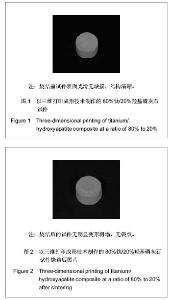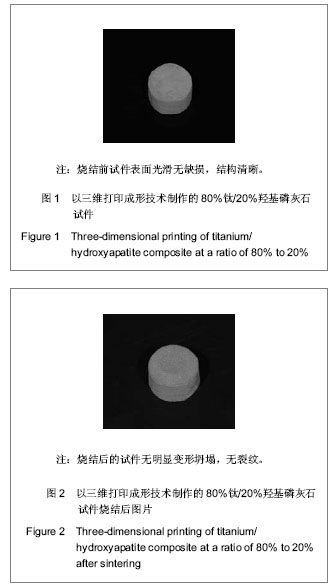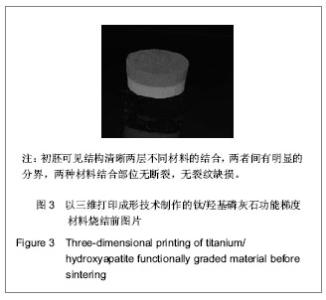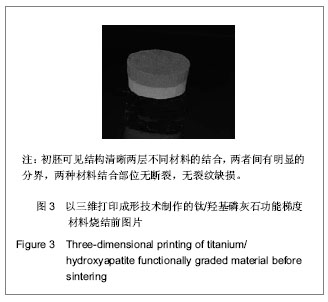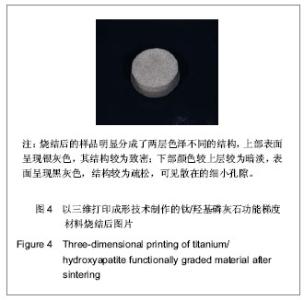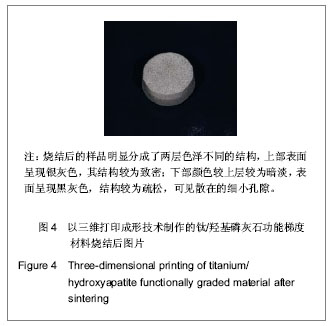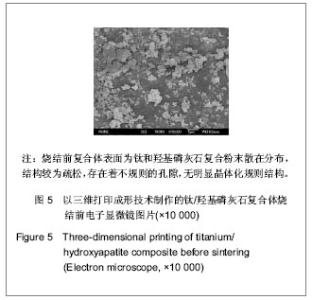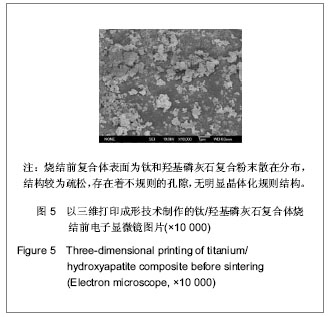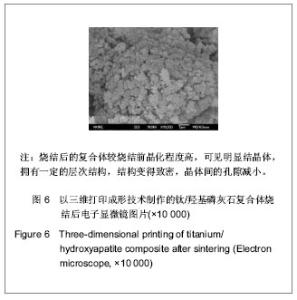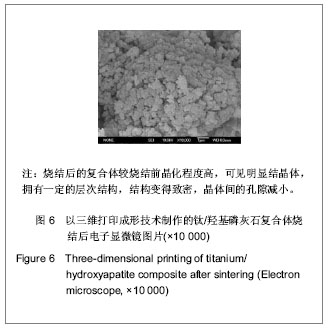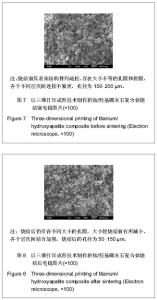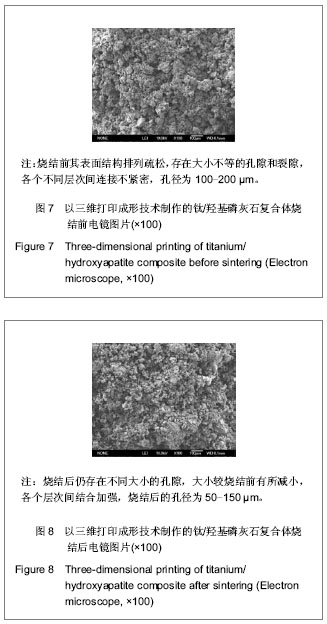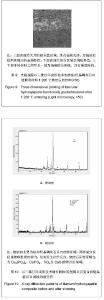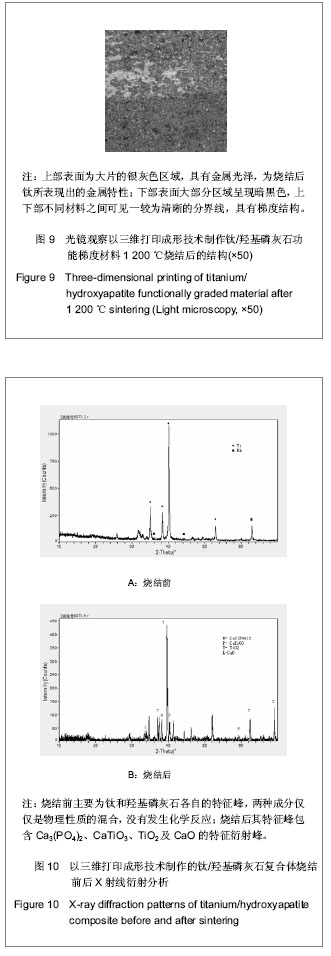Chinese Journal of Tissue Engineering Research ›› 2013, Vol. 17 ›› Issue (29): 5364-5370.doi: 10.3969/j.issn.2095-4344.2013.29.016
Previous Articles Next Articles
Three-dimensional printing of titanium/hydroxyapatite composite and functionally graded materials
Qian Chao, Fan Ying-zi, Sun Jian
- Department of Prosthodontics, the Ninth People’s Hospital, School of Medicine, Shanghai Jiao Tong University, Shanghai Key Laboratory of Stomatology, Shanghai 200011, China
-
Received:2012-11-10Revised:2012-12-19Online:2013-07-22Published:2013-07-22 -
Contact:Sun Jian, Associate chief physician, Department of Prosthodontics, the Ninth People’s Hospital, School of Medicine, Shanghai Jiao Tong University, Shanghai Key Laboratory of Stomatology, Shanghai 200011, China -
About author:Qian Chao★, Master, Physician, Department of Prosthodontics, the Ninth People’s Hospital, School of Medicine, Shanghai Jiao Tong University, Shanghai Key Laboratory of Stomatology, Shanghai 200011, China qianch1987@yahoo.com.cn -
Supported by:the Leading Academic Discipline (Featured Ddisciplines) Construction Fund Project of Shanghai City, No. T0202*, S30206*; the Natural Science Foundation of Shanghai City, No. 09ZR1416600*
CLC Number:
Cite this article
Qian Chao, Fan Ying-zi, Sun Jian . Three-dimensional printing of titanium/hydroxyapatite composite and functionally graded materials[J]. Chinese Journal of Tissue Engineering Research, 2013, 17(29): 5364-5370.
share this article
| [1] Gibson LJ. The mechanical behaviour of cancellous bone. J Biomech.1985; 18(5): 317-328.[2] Liu QB,Leu MC,Schmitt SM. Rapid prototyping in dentistry: technology and application.Int J Adv Manuf Technol.2006; 29(3): 317-335.[3] Wen CE,Mabuchi M,Yamada Y,et al. Processing of biocompatible porous Ti and Mg. Script Material.2001;45(10): 1147-1153.[4] Chen YJ,Feng B,Zhu YP,et al.Fabrication of porous titanium implants with biomechanical compatibility.Mater Lett.2009; (63): 2659-2661.[5] Szilvia E,Dermot B,Stefan L,et al.Selective laser sintering of hydroxyapatite/poly-ε-caprolactone scaffolds.Acta Biomater. 2010;6: 2511-2517.[6] Li LH,Kommareddy KP,Pilz C,et al.In vitro bioactivity of bioresorbable porous polymeric scaffolds incorporating hydroxyapatite microspheres. Acta Biomater.2010;6(7): 2525-2531.[7] Ning CQ,Zhou Y.On the microstructure of biocomposites sintered from Ti, HA and bioactive glass.Biomaterial.2004; 25(17):3379-3387.[8] Salman S,Gunduz O,Yilmaz S,et al. Sintering effect on mechanical properties of composites of natural hydroxyapatites and titanium.Ceram Int. 2009;35(7): 2965-2971.[9] Pompe W,Worch H,Epple M,et al. Functionally graded materials for biomedical applications. Mater Sci Eng A.2003;362(1-2):40-60. [10] Hedia HS,Mahmoud NA.Design optimization of functionally graded dental implant. Biomed Mater Eng.2004;14(2): 133-143.[11] Lin D,Li Q,Li W,et al.Functionally Graded Dental Implant and Its Effect on Bone Remodeling.Advanced Mater Res. 2008; 47-50:1035-1038.[12] Azari A,Nikzad S. The evolution of rapid prototyping in dentistry:A review. Rapid Prototyping J.2009;15(3):216-225.[13] Lam CXF,Mo XM,Teoh SH,Scaffold development using 3D printing with a starch-based polymer. Mater Sci Eng C.2002; 20(1-2):49-56.[14] Kieback B,Neubrand A,Riedel H.Processing techniques for functionally graded materials. Mater Sci Eng A.2003;362(1): 81-105.[15] Chu C,Zhu J,Yin Z,et al.Structure optimization and properties of hydroxyapatits-Ti symmetrical functionally graded biomaterial. Mater Sci Eng A.2001;A316:205-210.[16] Watari F,Yokoyama A,Saso F,et al.Fabrication and properties of functionally graded dental implant.Comp Part B Eng. 1997;28(1):5-11.[17] Ning CQ,Zhou Y. Correlations between the in vitro and in vivo bioactivity of the Ti/HA composites fabricated by a powder metallurgy method.Acta Biomater.2008;4(6): 1944-1952.[18] 宁聪琴,周玉,孟庆昌.50Ti/HA生物材料的组织结构与体外生物活性[J].无机材料学报,2001,16(2): 263-268.[19] Hench L.Bioceramics.J Am Ceram Soc.1998;81(7): 1705-1728. [20] Tampieri A,Gelotti G,Szontagh F,et al.Sintering and characterization of HA and TCP bioceramics with control of their strength and phase purity. J Mater Sci Mater Med. 1997;8(1): 29-37.[21] 阮建明,邹俭鹏. HA-Ti和HA-BG-Ti复合生物材料的力学性能和微观结构[J].中国有色金属学报,2003,13(8): 1361-1367.[22] Kieback B,Neubrand A,Riedel H.Processing techniques for functionally graded materials. Mater Sci Eng A.2003; 362(1): 81-105.[23] Wang J,Shaw L.Fabrication of Functionally Graded Materials Via Inkjet Color Printing.J Am Ceram Soc.2006;89(10): 3285-3289. |
| [1] | Chen Ziyang, Pu Rui, Deng Shuang, Yuan Lingyan. Regulatory effect of exosomes on exercise-mediated insulin resistance diseases [J]. Chinese Journal of Tissue Engineering Research, 2021, 25(25): 4089-4094. |
| [2] | Jiang Xiaoyan, Zhu Haifei, Lin Haiqi, Lin Wentao. Cold therapy promotes self-limited recovery of delayed-onset muscle soreness [J]. Chinese Journal of Tissue Engineering Research, 2021, 25(23): 3609-3613. |
| [3] | Xie Jingshu, Zhang Xianglin, Liu Jinlei, Wen Jing. Application of High Resolution reconstruction algorithm in precision CT scans of the middle and inner ears [J]. Chinese Journal of Tissue Engineering Research, 2021, 25(23): 3614-3618. |
| [4] | Liu Jinwei, Chen Yunzhen, Wan Chunyou. Changes of osteogenic growth factors in the broken end of bone nonunion under stress [J]. Chinese Journal of Tissue Engineering Research, 2021, 25(23): 3619-3624. |
| [5] | Luo Anyu, Liu Hanlin, Xie Xiaofei, Huang Chen. Effect of antioxidant mixture on structural degeneration of an osteoarthritis rat model [J]. Chinese Journal of Tissue Engineering Research, 2021, 25(23): 3625-3629. |
| [6] | Zhou Wu, Wang Binping, Wang Yawen, Cheng Yanan, Huang Xieshan. Transforming growth factor beta combined with bone morphogenetic protein-2 induces the proliferation and differentiation of mouse MC3T3-E1 cells [J]. Chinese Journal of Tissue Engineering Research, 2021, 25(23): 3630-3635. |
| [7] | Gao Kun, Chen Dayu, Zhang Yong, Liu Weidong, Sun Shufen, Lai Wenqiang, Ma Dujun, Wu Yihong, Lin Zhanpeng, Jiang Yinglu, Yu Weiji. Achyranthes bidentata alcohol extract inhibits extracellular matrix degradation of the cartilage by regulating synovial fibroblast exosomes [J]. Chinese Journal of Tissue Engineering Research, 2021, 25(23): 3636-3640. |
| [8] | Liang Meifu, Qu Shuhua. Optimal power load forecasting of the skeletal muscle based on back propagation neural network [J]. Chinese Journal of Tissue Engineering Research, 2021, 25(23): 3641-3647. |
| [9] | Bai Shengchao, Gao Yang, Wang Bo, Li Junping, Wang Ruiyuan. Dynamic changes of mitochondrial function of the skeletal muscle after acupuncture intervention in rats with heavy load exercise-induced injury [J]. Chinese Journal of Tissue Engineering Research, 2021, 25(23): 3648-3653. |
| [10] | Yang Caihui, Liu Qicheng, Dong Ming, Wang Lina, Zuo Meina, Lu Ying, Niu Weidong. Serine/threonine protein kinases can promote bone destruction in mouse models of chronic periapical periodontitis [J]. Chinese Journal of Tissue Engineering Research, 2021, 25(23): 3654-3659. |
| [11] | Fan Junchao, Chen Yong, Song Junjie. Sevoflurance combined with xenon pretreatment protects against spinal cord ischemia-reperfusion injury in a rat model [J]. Chinese Journal of Tissue Engineering Research, 2021, 25(23): 3660-3665. |
| [12] | Zuo Zhenkui, Han Jiarui, Ji Shuling, He Lulu. Pretreatment with ginkgo biloba extract 50 alleviates radiation-induced acute intestinal injury in mice [J]. Chinese Journal of Tissue Engineering Research, 2021, 25(23): 3666-3671. |
| [13] | Zhang Liang, Ma Xiaoyan, Wang Jiahong. Regulatory mechanism of Shenshuai Yin on cell apoptosis in the kidney of chronic renal failure rats [J]. Chinese Journal of Tissue Engineering Research, 2021, 25(23): 3672-3677. |
| [14] | Cheng Yanan, Wu Yucong, Mao Qiuhua, Chen Ling, Lu Liying, Xu Pu. Restoration effect and stability of resin infiltration combined with bioactive glass on demineralized tooth enamel [J]. Chinese Journal of Tissue Engineering Research, 2021, 25(22): 3522-3526. |
| [15] | Bi Qingwei, Liu Chengpu, Li Yan, Zhao Wenwen, Han Mei. Structure analysis of platelet-rich fibrin derived from two centrifugation procedures [J]. Chinese Journal of Tissue Engineering Research, 2021, 25(22): 3534-3539. |
| Viewed | ||||||
|
Full text |
|
|||||
|
Abstract |
|
|||||
